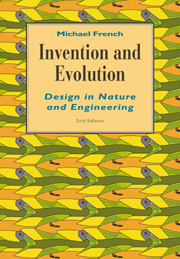Book contents
- Frontmatter
- Contents
- Preface to the second edition
- Preface to the first edition
- Acknowledgements
- 1 The designed world
- 2 Energy
- 3 Materials
- 4 Mechanism
- 5 Structures
- 6 Systems
- 7 The practice, principles and philosophy of design
- 8 Economy, form and beauty
- 9 Production, reproduction, evolution and design
- 10 Designing and inventing
- 11 Some case studies
- Questions
- Answers
- Suggestions for further reading
- Index
2 - Energy
Published online by Cambridge University Press: 06 January 2010
- Frontmatter
- Contents
- Preface to the second edition
- Preface to the first edition
- Acknowledgements
- 1 The designed world
- 2 Energy
- 3 Materials
- 4 Mechanism
- 5 Structures
- 6 Systems
- 7 The practice, principles and philosophy of design
- 8 Economy, form and beauty
- 9 Production, reproduction, evolution and design
- 10 Designing and inventing
- 11 Some case studies
- Questions
- Answers
- Suggestions for further reading
- Index
Summary
Energy
It is often helpful to think of the designer as working in three different kinds of medium – materials, energy and information. Materials are the most readily appreciated, but it is convenient to study energy first because it introduces ideas which are essential to the consideration of materials: information is left until Chapter 6.
An aircraft can fly the Atlantic because it can store a great deal of energy in chemical form in fuel and convert that energy reasonably efficiently into other forms as required. An aircraft or a bird can take off and fly because of its ability to convert or release energy at a high rate – the rate of conversion or release of energy is called power.
The ability of a bird or a mammal to survive in cold weather depends on its ability to keep down its loss of heat, which is a form of energy, and the protection that a vehicle offers its occupants in a collision depends largely on the capacity of its structure to absorb the destructive energy of motion (kinetic energy). All life depends on energy: plant life draws its energy from the rays of the sun, and animals in turn obtain energy by eating plants or other animals. At another extreme, a clothes-peg or a nut-and-bolt depend for their functioning on their power of storing a little energy, as we shall see.
- Type
- Chapter
- Information
- Invention and EvolutionDesign in Nature and Engineering, pp. 23 - 53Publisher: Cambridge University PressPrint publication year: 1994



